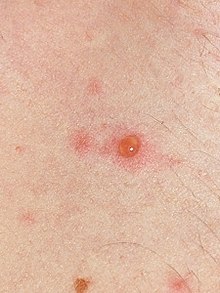Exposure to VZV in a healthy child initiates the production of host immunoglobulin G (IgG),immunoglobulin M (IgM), and immunoglobulin A (IgA) antibodies; IgG antibodies persist for life and confer immunity. Cell-mediated immune responses are also important in limiting the scope and the duration of primary varicella infection. After primary infection, VZV is hypothesized to spread frommucosal and epidermal lesions to local sensory nerves. VZV then remains latent in the dorsal ganglion cells of the sensory nerves. Reactivation of VZV results in the clinically distinct syndrome of herpes zoster (i.e., shingles), and sometimes Ramsay Hunt syndrome type II.
[edit]Infection in pregnancy and neonates
For pregnant women, antibodies produced as a result of immunization or previous infection are transferred via the placenta to the fetus.[11] Women who are immune to chickenpox cannot become infected and do not need to be concerned about it for themselves or their infant during pregnancy.[12]
Varicella infection in pregnant women could lead to viral transmission via the placenta and infection of the fetus. If infection occurs during the first 28 weeks of gestation, this can lead to fetal varicella syndrome (also known as congenital varicella syndrome).[13] Effects on the fetus can range in severity from underdeveloped toes and fingers to severe anal and bladder malformation. Possible problems include:
- Damage to brain: encephalitis,[14] microcephaly, hydrocephaly, aplasia of brain
- Damage to the eye: optic stalk, optic cup, and lens vesicles, microphthalmia, cataracts,chorioretinitis, optic atrophy
- Other neurological disorder: damage to cervical and lumbosacral spinal cord, motor/sensory deficits, absent deep tendon reflexes, anisocoria/Horner's syndrome
- Damage to body: hypoplasia of upper/lower extremities, anal and bladder sphincter dysfunction
- Skin disorders: (cicatricial) skin lesions, hypopigmentation
Infection late in gestation or immediately following birth is referred to as "neonatal varicella".[15]Maternal infection is associated with premature delivery. The risk of the baby developing the disease is greatest following exposure to infection in the period 7 days prior to delivery and up to 7 days following the birth. The baby may also be exposed to the virus via infectious siblings or other contacts, but this is of less concern if the mother is immune. Newborns who develop symptoms are at a high risk of pneumonia and other serious complications of the disease.[9]

